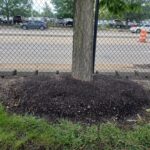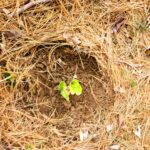As the Midwest gardening season winds down, there’s still one task that can make a big difference come spring: mulching. Once the soil has cooled but before it freezes, a layer of mulch helps protect plant roots from the freeze-thaw cycles common in Midwestern winters. Mulch stabilizes soil temperatures, conserves moisture, and shields roots from cold, dry winds. Mulching too early, when the soil is still warm, can lead to problems such as increased rodent activity or delayed plant dormancy. Waiting until after several hard frosts ensures that plants have entered dormancy and the soil has cooled.
In addition to winter protection, organic mulch offers long-term benefits. It suppresses early spring weeds, reduces soil erosion, and improves soil structure as it decomposes. It also supports beneficial insects and soil organisms by maintaining a more stable and sheltered habitat.
The best mulch depends on the garden’s needs and available resources:
- Shredded leaves are abundant, easy to spread, and break down quickly to enrich the soil.
- Clean straw provides an excellent, lightweight insulation that’s ideal for garlic, strawberries, and overwintered vegetables.
- Compost can serve as both a mulch and soil amendment. Topping it with a coarser material, like wood chips, helps keep it in place over the winter (Fig. 1).
- Wood chips or bark offer long-lasting coverage and a tidy appearance (Fig. 2). Keep mulch a few inches from trunk; no volcano mulching (Fig. 3).
- Pine needles are lightweight and decompose slowly (Fig. 4). While fresh needles are acidic, they become nearly neutral during decomposition and do not significantly acidify the soil.
Some materials are best avoided, or used with care, due to potential risks. Fresh grass clippings tend to mat and retain excess moisture, which can lead to rot. Mulch made from diseased plants may harbor pathogens and spread disease. Mulch from black walnut trees contains juglone, a natural compound toxic to many landscape plants including peonies, hydrangeas, and viburnum.
Apply mulch to a depth of 2 to 4 inches for most perennial and ornamental plants. Tender perennials, bulbs, and garlic may benefit from up to 6 inches. Mulch should be applied loosely and kept a few inches away from plant crowns and tree trunks to prevent rot and disease (Fig. 5). If the soil is dry, irrigate deeply before mulching.
Taking time to mulch in late fall is an investment in next year’s garden. When spring arrives, expect healthier soil, fewer weeds, and stronger perennials.
- Figure 1. Covering compost with a layer of wood chips keeps nutrients in place and protects the soil through winter.
- Figure 2. Wood chips create a clean, well-defined garden bed while conserving moisture and moderating soil temperature.
- Figure 3. Example of improper mulching, known as volcano mulching. Avoid piling mulch against the tree trunk to prevent decay and pest problems.
- Figure 4. Pine needle mulch is light, easy to spread, and decomposes slowly. Needles become nearly neutral as they decompose and have little effect on soil pH.
- Figure 5. Keep mulch a few inches from the trunk and exposed surface roots. When possible, extend the mulch out to the tree’s drip line for maximum root protection and moisture retention.




